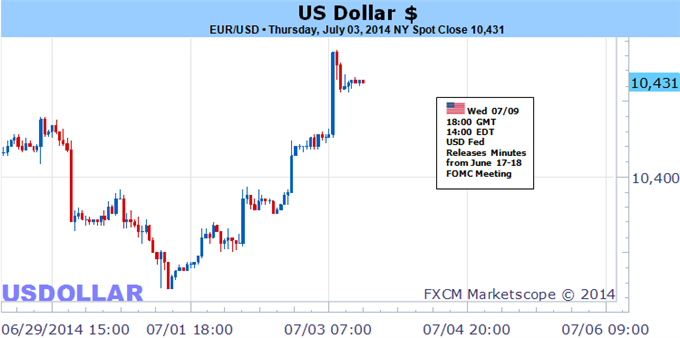US Dollar Fails to Break Despite Stellar NFPs. Where are the Trades?

Fundamental Forecast for Dollar: Bullish
- US Nonfarm Payrolls report beats all expectations, sends US Dollar higher
- Is the Dollar bounce a lasting one? Extreme sentiment suggests it is
- Watch the volume on dollar-based majors with the release of NFPS using the FXCM Real Volume indicator
The Dollar tumbled to fresh yearly lows through the past week, but a late week reversal actually left the Dow Jones FXCM Dollar Index (ticker: USDOLLAR) higher on the week. Is this the start of a more significant Dollar reversal?
A sharply better-than-expected US Nonfarm Payrolls report helped push the Dollar positive for the first time in the past six weeks. Yet a virtually empty US economic calendar leaves little hope of big moves in the week ahead. And indeed, 1-week Euro/US Dollar volatility expectations finished at record lows following the Nonfarm Payrolls report. Clearly most are betting on/hedging against extremely slow moves ahead, but why didn’t NFPs change that?
The US labor market data was about as strong as anyone could have hoped for, and strong employment growth should force the US Federal Reserve to tighten monetary policy more quickly than expected. Yet there needs to be more for markets to start pricing in Fed rate hikes. The US 2-year Treasury Yield—a great proxy for medium-term interest rate expectations—spiked on the NFPs report only to fall short at the 09/2013 high and likely stick to its long-standing trading range.
Where might we see bigger currency volatility? Follow the interest rates. The British Pound is an obvious candidate as it trades at post-financial crisis highs, and it should be little surprise to note that UK government bond yields trade at fresh multi-year peaks. The Euro should arguably be more sensitive to the fact that the European Central Bank has cut benchmark deposit rates into negative territory. Yet Euro Zone yields were already trading near zero percent even before recent ECB actions. Interest rate expectations remain muted in the US, Euro Zone, and across G10 currencies.
Thus if you can’t beat them, join them. It might be frustrating to trade in such low-volatility market conditions, but our real client data actually shows that most tend to do well in tight ranges.
There’s little sense in trading for big currency swings if market conditions remain as they are, and the fact that the US Dollar remains oversold against key counterparts and that in itself leaves us focused on USD gains in the week and month ahead. Indeed our Senior Strategist sees reason for continued EURUSD losses, and a look at our real forex sentiment data warns that a position extreme could likewise favor a Euro top. – DR
original source






 Indonesia
Indonesia